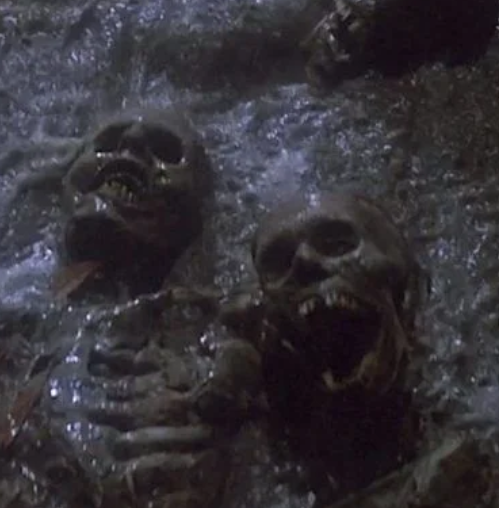the 1982 movie poltergeist used real skeletons as – tymoff is still talked about today for its creepy storyline and impressive special effects. Directed by Tobe Hooper and produced by Steven Spielberg, the movie featured a family terrorized by malevolent spirits in their suburban home. While it entertained audiences, the film also prompted controversy over its use of real human remains.
- The film involved a spiritually grounded family dealing with a supernatural presence that abducts their youngest daughter Carol Anne into “the other side.” As the family works to rescue her, they discover the frightening forces are angered by the graves beneath their house being disturbed.
- A key scene showed the skeletons of bodies long buried rising from the ground in the backyard. This effect was achieved in a shocking way – the production used real human skeletons and bones. While it made the shots more realistic, it raised ethical issues that have lingered for decades.
How the Skeletons Were Obtained
- It was revealed years later that director Hooper sourced over 100 real human skeletons and partial remains from medical schools and institutions to use in the famous graveyard sequence.
- The skeletons were purchased legally through medical supply companies. However, questions remain about whether proper permissions and respect were shown for the deceased individuals whose remains ended up in the movie.
- Some have argued this use of real human skeletal parts without the proper respect or permission crossed ethical lines, even if it was done within legal technicalities at the time. Others feel the realistic scare effect justified employing real bones over props.
Continued Controversy and Reactions
- When news of Poltergeist’s real skeletal source material emerged, it generated continued debate and controversy among both medical professionals and the general public.
- Critics argued real human remains should never be commercially purchased or exploited for entertainment purposes without the explicit prior consent of the deceased or their families. Supporters countered fake props may not have achieved the needed realism.
- The issue raised sensitive questions around the boundaries of using human remains and respect for the dead. While the film’s special effects genuinely shocked audiences, many felt real skeletons should have been off limits.
- Medical institutions have since strengthened policies around appropriate use and storage of donated remains to prevent similar situations. Most modern films seeking realistic human bone effects opt to use detailed prosthetic replacements instead.
The Legacy of the Scene’s Realism
- Despite the ethical debates, there is no doubt employing real human skeletons made the iconic graveyard sequence in Poltergeist profoundly unsettling and realistically creepy for viewers.
- It represented a milestone in pushing horror movie practical effects to new disturbing levels that captivated audiences. The bone-chilling realism of actual skeletons rising from the dirt still gives the scene its power today.
- While opinions differ on the choice, the sequence is still discussed and remembered for its ability to genuinely frighten viewers like few movie scenes before it. In that sense, it was a triumph of realistic horror craft, even if some question the means used.
- Whether justified or not, Poltergeist’s use of real human remains to scare audiences became an indelible part of its disturbing legacy and place in film history. The choice reinforced why it remains one of the most unsettling haunted house movies ever made.
The Behind-the-Scenes Controversy
While the on-screen effects fascinated viewers, the revelation of real human bones usage ignited debates among film professionals too:
- Many questioned if Producer Spielberg, who had final cut approval, should have known and put a stop to using real human remains without permission or respectful handling.
- Director Hooper maintained it was a decision left entirely up to medical effects technicians, but some felt bigger picture responsibility lay higher up the chain of command.
- Stories also emerged of skeletons being callously dumped afterwards without reburial, worsening the ethical issues. Proper storage and posthumous respect were bigger concerns than just legal purchasing.
- The conversation forced an examination of where to appropriately draw lines around depicting the human condition or remains realistically for entertainment. Balancing realism and respect became an ongoing topic.
- Unclear documentation and policies from the time make it difficult to assign definitive blame decades later. But the choice highlighted an instance where the ends did not justify the means for some.
- Overall it emphasized filmmaking’s power must be balanced with thoughtful consideration for any human impacts, intended or not. Realism alone cannot excuse insensitivity towards life and death.
The Legacy of Controversy
While the passage of time has not resolved every debate, Poltergeist’s use of real human skeletons did prompt the industry to carefully reconsider the handling of human remains. Key impacts and lessons included:
- Medical schools and suppliers tightened policies for appropriate release and use of donated remains to prevent similar unethical exploitation.
- Filmmakers grew warier of pushing realism without limit and disrespecting human dignity, even after death. Sensitivity increased across the board.
- Audiences became more conscious of where realistic effects end and the human toll may begin. Respectful handling of human subjects, real or portrayed, matters.
- The choice underscored how creations can take on lives of their own once launched, for better or worse, with ramifications hard to foresee.
- Discussions around the scene left a mark, ensuring aftermaths and impacts will continue to shape ethics on depictions involving human life in its many forms.
In the end, Poltergeist”s seminal graveyard sequence shook audiences while igniting ethical questions that still resonate today. By pushing boundaries to gratuitous ends, it highlighted filmmaking’s duty to cautiously wield its powerful illusions. When the line is crossed, some realities cannot be undone.

